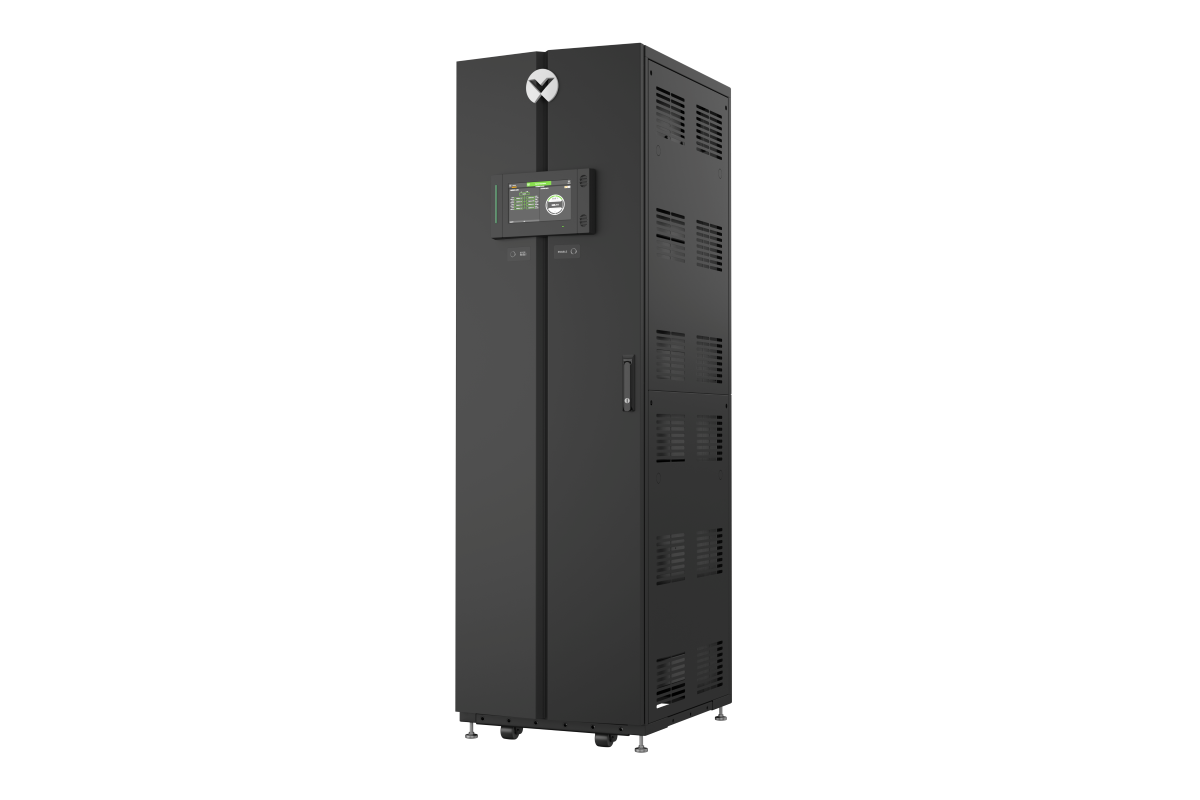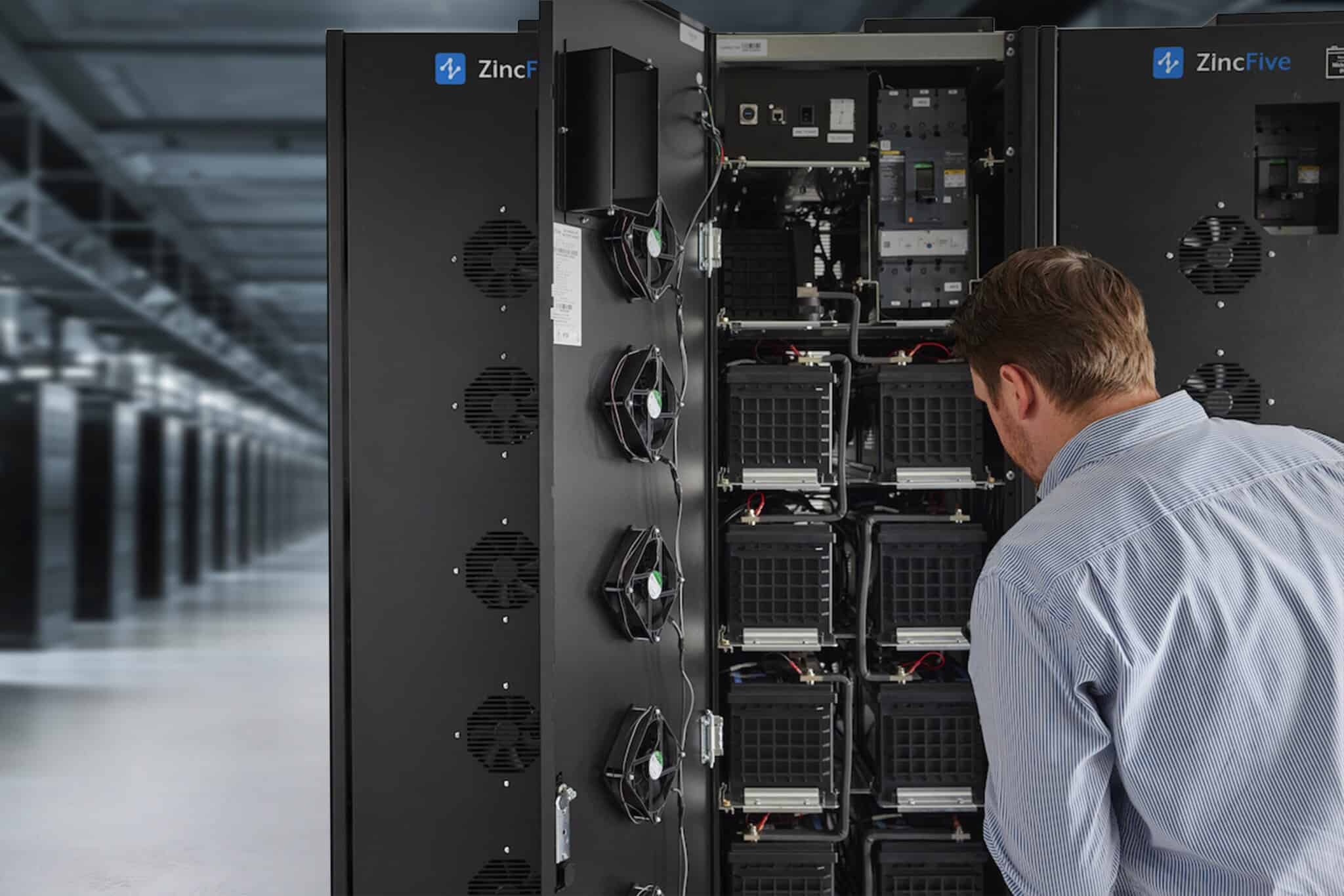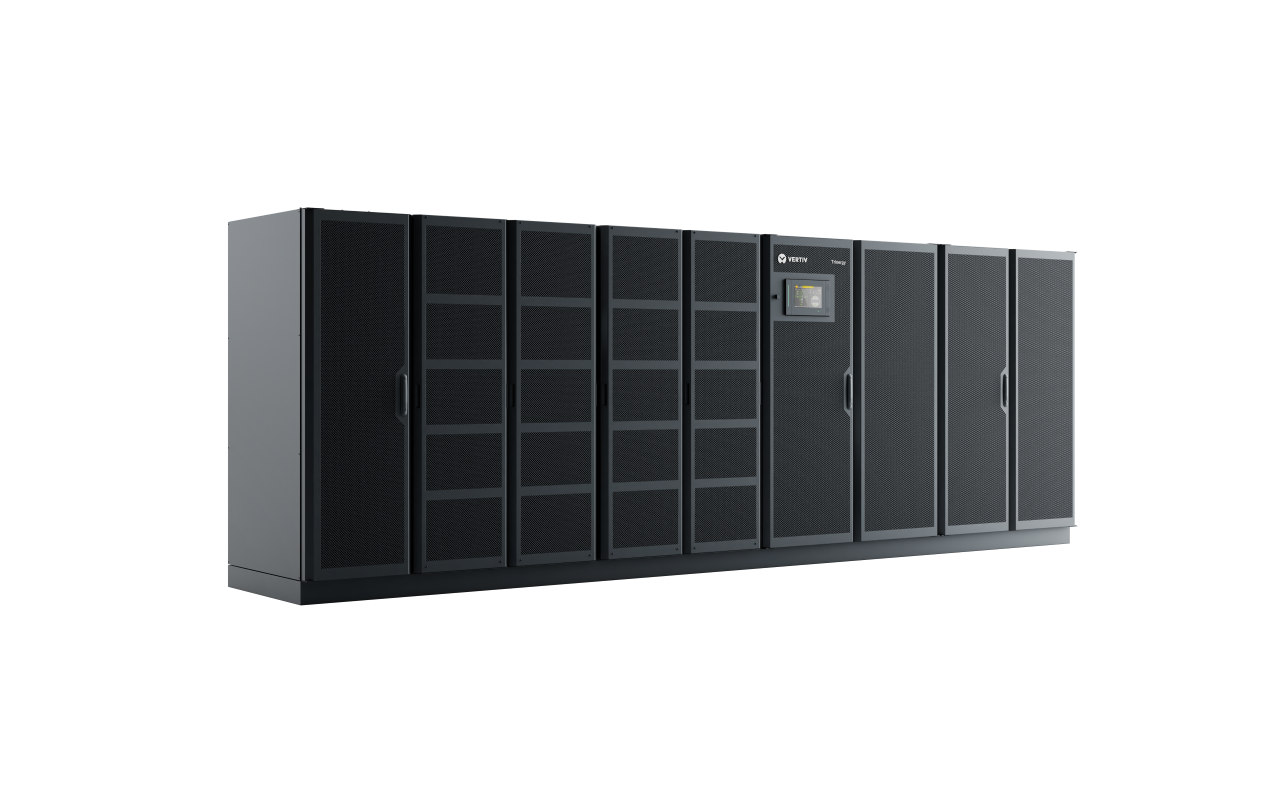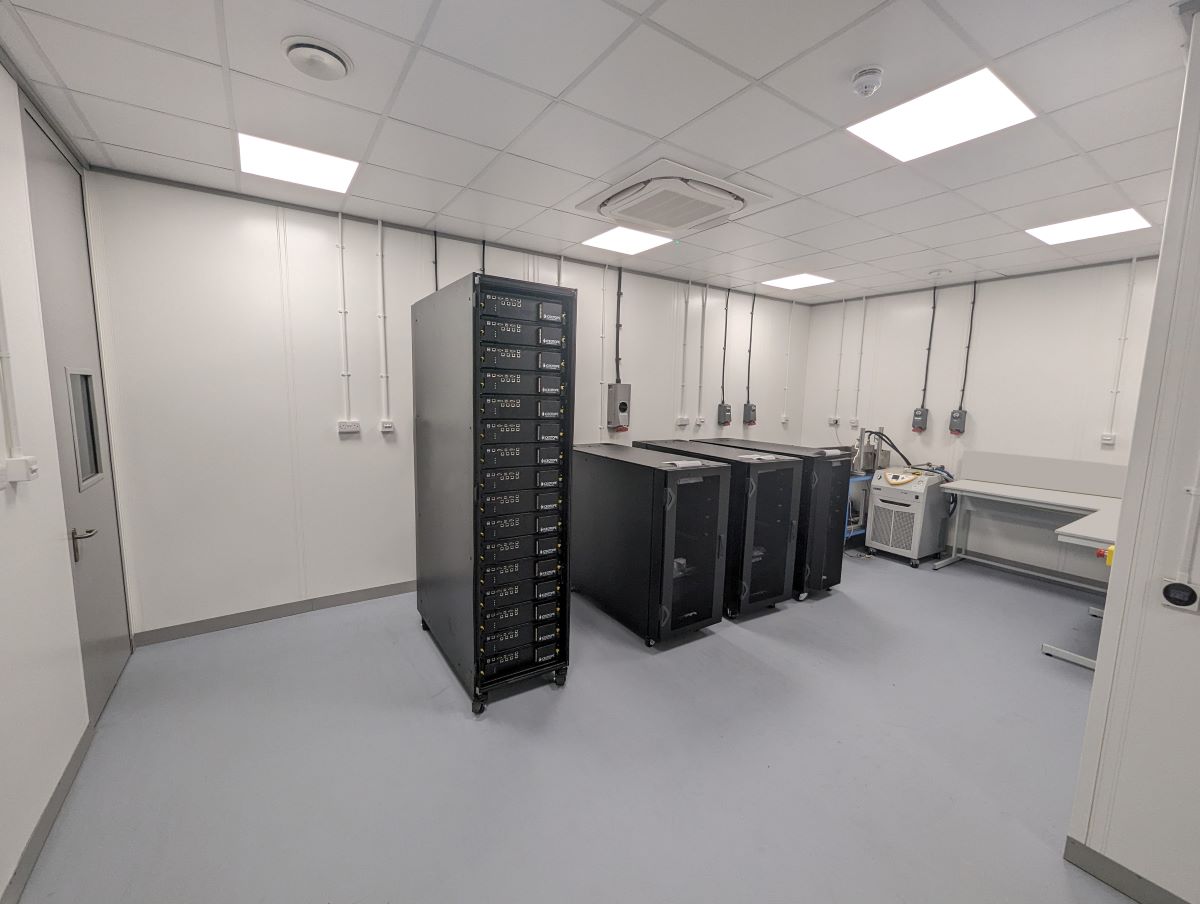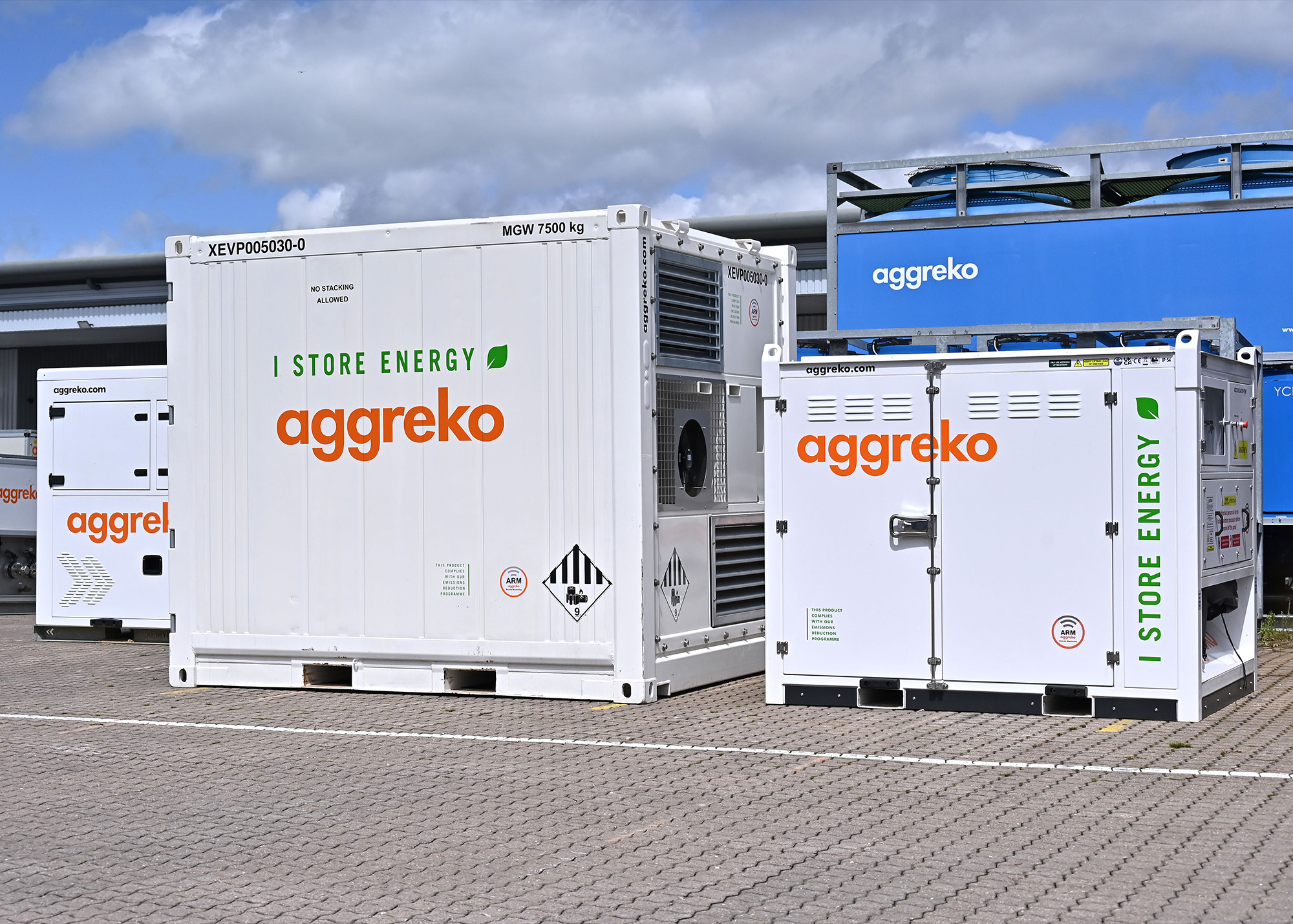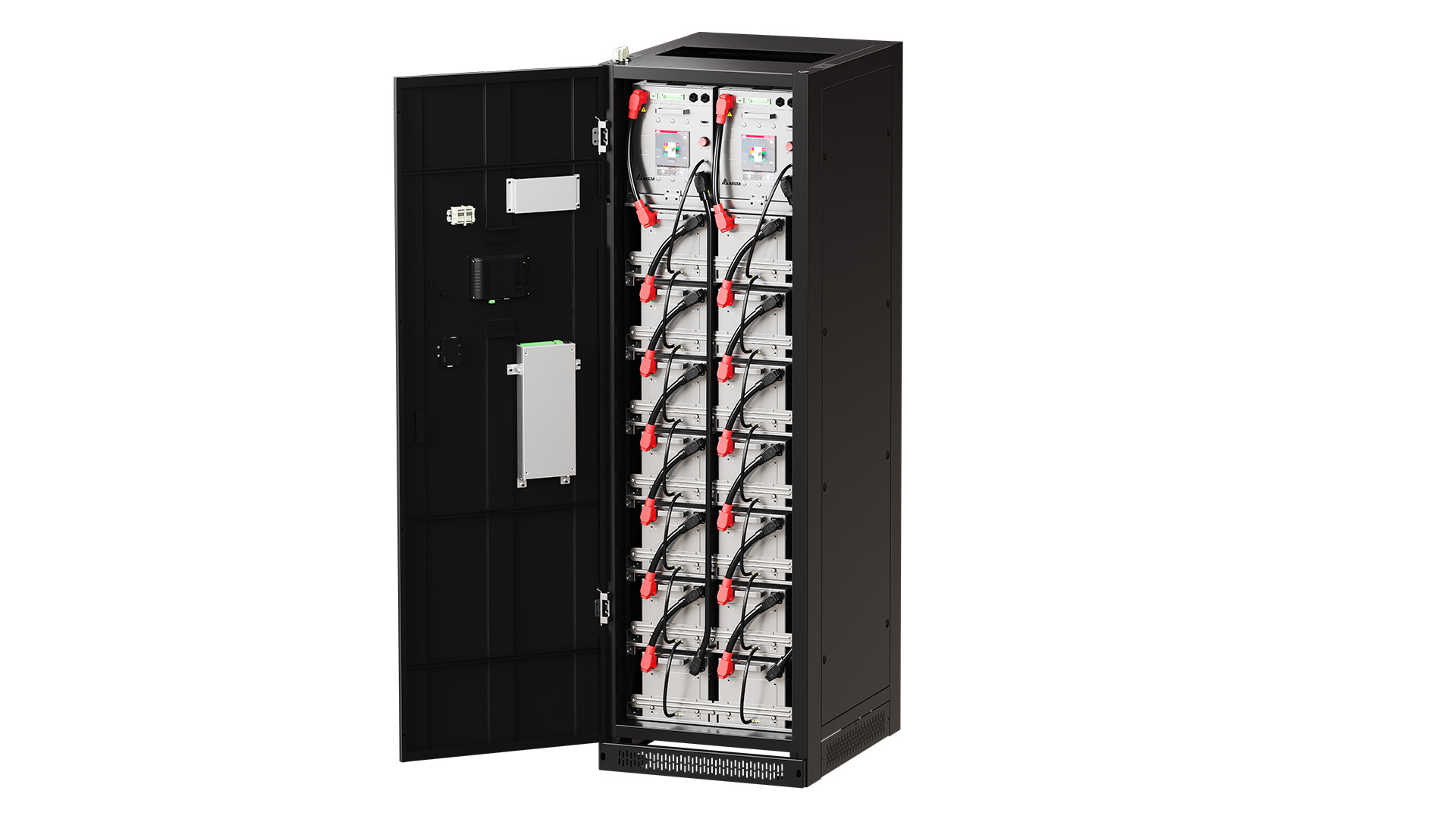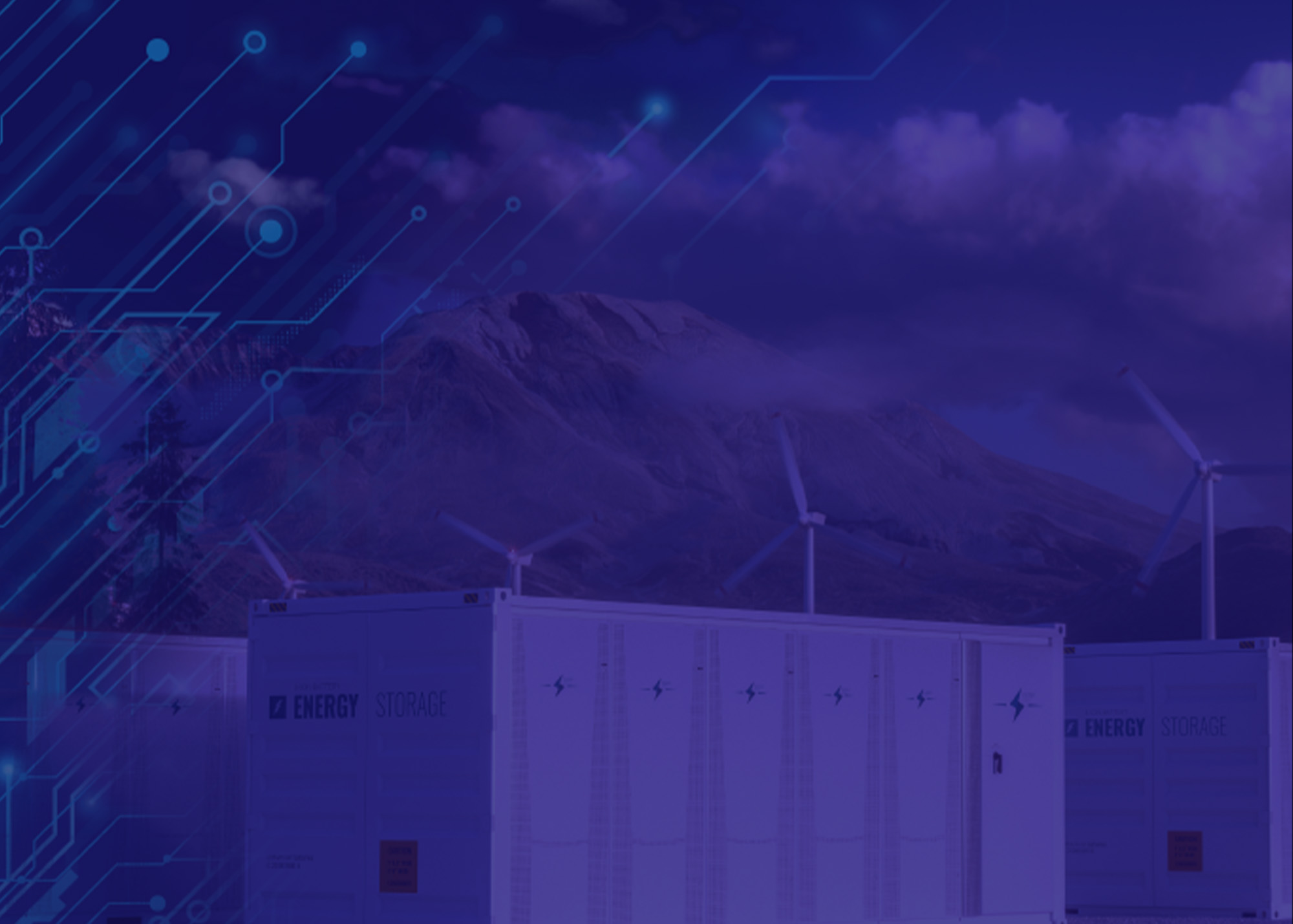Innovations in Data Center Power and Cooling Solutions
Data Centre Infrastructure News & Trends
Data Centres
Innovations in Data Center Power and Cooling Solutions
News
Vertiv introduces EnergyCore battery cabinets
Designed to meeting the urgent need for solutions supporting high-density computing in increasingly crowded data centre facilities, Vertiv, a global provider of critical digital infrastructure and continuity solutions, has introduced Vertiv EnergyCore battery cabinets.
Factory assembled with LFP (Lithium-Iron-Phosphate) battery modules and Vertiv’s internally-powered battery management system, Vertiv EnergyCore cabinets are available globally and are qualified for use with most current and legacy three-phase Vertiv uninterruptible power supply (UPS) systems, including the recently launched Vertiv Trinergy.
Vertiv EnergyCore cabinets are optimised for five minutes end-of-life runtime at 263kWb per each compact, 24” wide (600mm) cabinet, and operate across a wide temperature range, making them suitable for high-density environments. Lithium batteries are more compact and lighter than VRLA alternatives, allowing users to deploy fewer battery cabinets in most applications. An internal two-hole lug eliminates the need for a conduit box, and the cabinets require no on-site external control wiring, reducing deployment time and cost compared to traditional on-site assembly. The cabinets are equipped with Vertiv’s intuitive interactive touch screen HMI display to provide visibility and control of the cabinet, operating system, and the installed batteries.
The integrated battery management system is powered by the Vertiv EnergyCore batteries, removing the requirement for an external power source and simplifying installation. It provides lifetime onboard data storage, tracking performance over battery charge-discharge cycles, service events, and enabling accurate state-of-health reports that can be used for warranty support and predictive analytics. Remote battery monitoring is available via Vertiv Alber Battery Xplorer Enterprise.
“The proliferation of AI and other high-performance computing applications is putting a premium on the ability to deliver more power in smaller, hotter spaces,” says Milind Paranjape, Vice President of Energy Storage at Vertiv. “With the Vertiv EnergyCore battery cabinets, Vertiv is delivering exactly what its customers and the industry need – compact, high power energy storage capable of operating safely and optimally. Simply put, these battery cabinets are designed for the emerging mission-critical needs of high-density computing environments.”
The modular design of Vertiv Trinergy allows each UPS core to be paired with dedicated Vertiv EnergyCore battery cabinets in a distributed architecture, enabling uninterrupted service for critical applications. Due to the power density of the Vertiv EnergyCore design, only two lithium-ion battery cabinets are needed to support each 500kW Trinergy UPS core, versus the three cabinets that are required by most suppliers.
Vertiv EnergyCore is UL 1973 listed and has been successfully tested for compliance to UL 9540A standard for protection against thermal runaway fire propagation in battery energy storage systems, which, according to NFPA 855 ESS installation standards, means the three feet (92cm) spacing requirements between racks can be waived by the Authorities Having Jurisdiction. This can save space and speed deployment.
For more from Vertiv, click here.
Simon Rowley - 9 October 2024
Data Centre Infrastructure News & Trends
Innovations in Data Center Power and Cooling Solutions
News
Vertiv expands single-phase UPS portfolio
Vertiv, a global provider of critical digital infrastructure and continuity solutions, has introduced 1kVA to 3kVA capacities of the Vertiv Liebert GXE, an online double conversion, single-phase uninterruptible power supply (UPS) for 230V applications designed to support critical applications deployed at the network edge.
With the addition of the new models, the Liebert GXE family is now available in a complete 1kVA to 10kVA capacities range and is ready for immediate shipping from stock within Europe, the Middle East, and Africa (EMEA), Asia, and LATAM warehouses.
The Liebert GXE 1-3KVA UPS is available in a compact tower-only model or in a flexible rack/tower convertible design and delivers high efficiencies of up to 91% in online mode and up to 96% in ECO mode. It features a battery management system that supports prolonged battery lifespan and minimises the need for replacements. Additionally, its output power factor of 0.9 allows for more active loads to be connected within a given space, while its online double conversion technology protects equipment from power disturbances.
The Liebert GXE rack/tower models provide scalable runtime for applications that need extended backup during AC mains outages, achievable by adding up to four external battery cabinets, and a fast recharge time thanks to its powerful 6 Amp internal charger. The hot-swappable VRLA batteries are user-replaceable without needing skilled personnel or powering down the loads, ensuring smooth operation and reduced maintenance costs.
In addition, the Liebert GXE features an intuitive LCD display that offers insights into the UPS status, facilitating straightforward installation and operation. This unit provides remote monitoring capabilities, enabling convenient access to IT infrastructure via the optional Vertiv Liebert Intellislot Unity Communications card, along with a complimentary download of the Vertiv Power Insight software.
Finally, Vertiv offers a wide service offering including limited warranty extensions, power emergency packages, and other options, depending on the country and UPS model.
“The rapid advancement of digitalisation, including AI and the growing reliance on data services, makes power continuity increasingly crucial for all businesses, even at the network edge," states Andrea Ferro, Vice President for Channel, IT and Edge Applications at Vertiv in EMEA. "The Liebert GXE provides energy-efficient and reliable power protection, helping small and medium businesses sustain operations in these distributed applications."
The UPS is available with a comprehensive range of limited warranty extensions and service programmes designed for single-phase UPS systems. These service programmes are available in select countries; visit Vertiv's website for specific availability or contact your local representative.
EMEA resellers in participating countries can earn points through the Vertiv Incentive Programme (VIP) for various activities, including sales of the Liebert GXE and other products in Vertiv’s IT channel portfolio. This programme allows partners to win rewards, without any need for reporting. Bonus points are added to the Vertiv Partner Portal monthly, and partners simply need to log in to redeem them.
For more from Vertiv, click here.
Simon Rowley - 24 July 2024
Data Centre Infrastructure News & Trends
Data Centres
Innovations in Data Center Power and Cooling Solutions
News
Vertiv and ZincFive collaborate to deliver safe energy storage
Vertiv, a global provider of critical digital infrastructure and continuity solutions, and ZincFive, a provider of nickel-zinc (NiZn) battery-based products for immediate power applications, today announced that Vertiv will add the ZincFive BC Series uninterruptible power supply (UPS) Battery Cabinets to its portfolio of battery systems available for data centre backup power.
The safe and recyclable nickel-zinc batteries are compatible with select large and medium Vertiv UPS systems, including the recently launched Vertiv Trinergy, as a source of backup energy storage, complementing the company’s commitment to enable customers to minimise the environmental footprint of their data centre sites. The ZincFive BC Series UPS Battery Cabinets are now available from Vertiv in the EMEA region.
ZincFive’s BC Series UPS Battery Cabinets are reportedly the first nickel-zinc battery energy storage solution with backward and forward compatibility with megawatt class UPS. The BC Series offers the smallest footprint in the industry compared to VRLA and Lithium-Ion, and minimal maintenance requirements. The NiZn chemistry provides reliable operation, with the battery strings remaining conductive, even with weak or depleted cells. In addition, according to a study performed by Boundless Impact and commissioned by ZincFive, ZincFive’s NiZn batteries have a significantly lower end-to-end environmental impact than lead-acid and lithium batteries, as validated by expert third-party analysis.
ZincFive's CEO and Co-Founder, Tim Hysell, comments, "Our relentless commitment to innovation shines through our powerful, safe, and reliable nickel-zinc battery technology. The BC Series represents an ideal solution to meet the evolving demands of data centres, both today and in the future. Furthermore, the importance of sustainability in data centre backup battery systems is on the rise, aligning perfectly with the shared values of ZincFive, our partners, and our customers. We are dedicated to minimising carbon emissions and operational expenses without compromising on safety or performance."
Milind Paranjape, Vertiv's Senior Director of Energy Storage, adds, "Vertiv and ZincFive want to enable reliable and efficiently operated data centres around the world, providing greater access to data, with less waste and greater energy efficiency. Vertiv has already deployed the ZincFive product at several sites for major data centre companies.”
Milind also said the technology is an excellent solution for customers faced with challenges with local Authorities Having Jurisdiction (AHJs) regarding National Fire Protection Association (NFPA) standards and the International Fire Code (IFC).
For more from Vertiv, click here.
Simon Rowley - 16 July 2024
Data Centre Infrastructure News & Trends
Data Centres
Innovations in Data Center Power and Cooling Solutions
News
Vertiv unveils next-generation Trinergy UPS
As global electricity demand from data centres is expected to double by 2026 – largely driven by computing and cooling requirements from AI and HPC (high-performance computing) – it is crucial to have a robust backup power solution to provide continuous availability of the GPUs and CPUs that run AI compute.
To address these challenges, Vertiv, a global provider of critical digital infrastructure and continuity solutions, today introduced Vertiv Trinergy, an uninterruptible power supply (UPS) engineered to handle the fluctuating load demands of data centres, and Vertiv PowerNexus, an integrated solution that provides space-saving close coupling of the UPS and system switchgear. Both solutions are available globally, with the Vertiv Trinergy UPS being available in 1500, 2000, and 2500 kVA capacities.
Vertiv calculates that Vertiv Trinergy exceeds Tier IV data centre power chain expected availability, with 99.9999998% projected uptime compared to 99.9994% – a difference between 30 seconds of downtime in 10 years for Vertiv Trinergy, compared to eight hours in 10 years as expected for the Tier IV data centre power chain. The system boosts resilience with extended backup time configurations and its innovative self-isolating core design, with modular architecture that features 500kW physically segregated cores. Each core includes the components of an online UPS: inverter, rectifier, booster/charger, and dedicated, segregated controls, allowing each core to operate independently, providing reliable uninterrupted power delivery even during maintenance.
"High-capacity power in a highly reliable system design is critical for data-intensive AI and HPC applications," states Kyle Keeper, SVP of Power Management Global Business unit at Vertiv. "Leveraging over 40 years of innovation, Vertiv Trinergy UPS offers the resilience essential for operations to become future-ready and to support AI loads. It delivers the flexibility required to adapt to various AI applications and is designed to integrate seamlessly with different prime and backup power sources, lithium-ion and nickel-zinc batteries, and alternative distributed energy sources, including fuel cells and long duration batteries (BESS)."
Vertiv Trinergy scales the concept of modularity up to all levels of the UPS architecture. Building blocks can be combined to fit different deployment types, achieving considerable space savings with its compact footprint. It streamlines power distribution through a single connection point, cutting down the necessity for numerous cables, flanges, bus ducts, and switchgear connections for UPS outputs.
Vertiv Trinergy footprint is further maximised when integrated with Vertiv PowerBoard Switchgear as part of the new Vertiv PowerNexus solution, close coupled into a single block connected by internal busbars. This integration also reduces cabling materials, installation time, and installation labour costs. The Vertiv PowerNexus is also available integrated onsite, as a power skid or integrated into an enclosure, providing flexibility to meet specific site needs. Vertiv PowerNexus integration is completed at the factory, saving installation time at the site. The integrated Vertiv EPMS (energy and power monitoring system) with onboard energy monitoring makes the system safer, more reliable and more operable out of the box by increasing visibility and reducing the number of interconnections.
The UPS may be supported by the Vertiv project and lifecycle services portfolio, which includes a new suite of data enabled services, including Vertiv LIFE advanced incident management and condition-based maintenance analytics and health scores.
Vertiv Trinergy delivers an outstanding double conversion efficiency of up to 97.1%, which further increases up to 99% with the Dynamic Online mode, reducing operating costs and energy dissipation. This significantly minimises the consumption of the cooling system, enabling an overall TCO reduction and shorter payback time.
The UPS can provide additional energy saving, as well as cost saving and revenue generation, by leveraging the Dynamic Grid Support feature, which allows the UPS to participate in demand management and other grid services, where available.
With its improved continuous duty booster operation, the UPS is capable of running from a DC source, even at full load, for an indefinite amount of time. The UPS is also compatible with Vertiv DynaFlex Battery Energy Storage System (BESS), which can leverage alternative energy sources for backup or primary power as part of a bring your own power (BYOP) strategy. The replacement of diesel generators as backup power can contribute to a lower mean time to repair (MTTR), and contributes to decarbonisation.
For more from Vertiv, click here.
Simon Rowley - 9 July 2024
Cooling
Data Centre Infrastructure News & Trends
Data Centres
Innovations in Data Center Power and Cooling Solutions
Liquid Cooling Technologies Driving Data Centre Efficiency
News
Iceotope launches state-of-the art liquid cooling lab
Iceotope Technologies, a global provider of precision liquid cooling technology, has announced the launch of Iceotope Labs, the first of its state-of-the-art liquid cooling lab facilities in Sheffield.
Designed to revolutionise high-density data centre research and testing capabilities for customers seeking to deploy liquid cooling solutions, Iceotope believes that its Iceotope Labs will set new standards as the industry's most advanced liquid-cooled data centre test environment available today.
Amid the exponential growth of AI and machine learning, liquid cooling is rapidly becoming an enabling technology for AI workloads. As operators evolve their data centre facilities to meet this market demand, validating liquid cooling technology is key to future-proofing infrastructure decisions.
By leveraging advanced monitoring capabilities, data analysis tools, and a specialist team of test engineers, Iceotope Labs will provide quantitative data and a state-of-the-art research and development (R&D) environment to demonstrate the benefits of liquid cooling to customers and partners seeking to utilise the latest advancements in high-density infrastructure and GPU-powered computing. Examples of recent research conducted by Iceotope Labs includes groundbreaking testing for next-gen chip level cooling at both 1500W and 1000W. These tests demonstrated precision liquid cooling’s ability to meet the thermal demands of future computing architectures needed for AI compute.
Working in partnership with Efficiency IT, a UK specialist in data centres, IT and critical communications environments, the first of Iceotope’s bespoke labs showcases the adaptability and flexibility of leveraging liquid cooling in a host of data centre settings including HPC, supercomputing and edge environments. The fully functional, small-scale liquid cooled data centre includes two temperature-controlled test rooms and dedicated space for thermal, mechanical and electronic testing for everything from next generation CPUs and GPUs to racks and manifolds.
Iceotope Labs also features a facility water system (FWS) loop, a technology cooling system (TCS) loop with heat exchangers, as well as an outside dry cooler – demonstrating key technologies for a complete liquid cooled facility. The two flexible, secondary loops are independent of each other and have a large temperature band to stress-test the efficiency and resiliency of a customers' IT equipment if and when required. Additionally, the flexible test space considers all ASHRAE guidelines and best practices to ensure optimal conditions for a range of test setups for enhanced control and monitoring all while maximising efficiency and safety.
"We are investing in our research and innovation capabilities to offer customers an unparalleled opportunity," says David Craig, CEO of Iceotope. “Iceotope Labs not only serves as a blueprint for what a liquid cooled data centre should be, but is also a collaborative hub for clients to explore liquid cooling solutions without the need for their own lab space. It's a transformative offering within the data centre industry."
David continues, “We’d like to thank Efficiency IT for its role in bringing Iceotope Labs to fruition. Its design expertise has empowered us with the flexibility needed to create a cutting-edge facility that exceeds industry standards."
“With new advancements in GPU, CPU and AI workloads having a transformative impact on both data centre design and cooling architectures, it’s clear to see that liquid cooling will play a significant role in improving the resiliency, energy and environmental impact of data centres,” adds Nick Ewing, MD, EfficiencyIT. “We’re delighted to have supported Iceotope throughout the design, development and installation of its industry-first Iceotope Lab, and look forward to building on our collaboration as together, we develop a new customer roadmap for high-density, liquid-cooled data centre solutions.”
Located at Iceotope's global headquarters in Sheffield, UK, Iceotope Labs further expands the location as a hub for technology innovation and enables Iceotope to continue to deliver the highest level of customer experience.
For more from Iceotope, click here.
Simon Rowley - 9 July 2024
Data Centre Infrastructure News & Trends
Innovations in Data Center Power and Cooling Solutions
News
Sustainable Infrastructure: Building Resilient, Low-Carbon Projects
Centiel to open new office in Kingdom of Saudi Arabia
Leading uninterruptible power supplies (UPS) manufacturer, Centiel, is opening a new office in the Kingdom of Saudi Arabia as the company continues to expand internationally.
Centiel’s manufacturing base for its award-winning UPS solutions is in Switzerland, and the company also has offices around the world including in the UK, Dubai, Abu Dhabi, Qatar and Singapore among others.
Gerado Lecuona, Co-Founder & Global Sales Director, Centiel, comments, “Our expansion is in line with Centiel's continued commitment to provide leading UPS solutions for organisations requiring high quality and more resilient technology for critical power protection in more international locations. It is essential that we maintain close relationships with our valued customers and regionally based offices ensure prompt technical support and delivery. We can also offer expert training as required locally, and our comprehensive approach underlines Centiel’s constant focus on excellence and responsiveness to deliver our industry leading critical power protection solutions.”
Following four years’ development, Centiel recently launched StratusPower, a true modular UPS to provide complete peace of mind in relation to power availability while helping data centres become more sustainable. StratusPower offers '9 nines' (99.9999999%) availability to effectively eliminate system downtime; safe semiconductor technology with a close to 98% VFI efficiency to minimise running costs; true 'hot swap' modules to eliminate human error in operation and also includes long-life components to improve sustainability and provide a 30-year useful working life. Uniquely, StratusPower has also been designed with the future of renewables, such as solar and wind, in mind.
In 2023, Centiel was confirmed as the recipient of a Frost & Sullivan Award for Technology Innovation Leadership in the Global UPS Industry and in 2024 Centiel was awarded for its outstanding contribution to sustainability and efficiency in the data centre market.
Centiel now protects critical loads for data centres and comms rooms in over 100 countries across five continents. For further information, visit centiel.com.
For more from Centiel, click here.
Simon Rowley - 3 July 2024
Innovations in Data Center Power and Cooling Solutions
Aggreko upscales battery investment to $200m
Aggreko has increased its global investment in mobile battery energy storage solutions (BESS) to around $200m, allowing more industries to access the latest in battery technology and reach net zero targets.
The global leader in energy solutions will be investing a significant proportion of this for growing it’s European BESS fleet to enable more customers to decarbonise their power provision, add resilience, improve efficiency and overcome power capacity constraints.
The introduction of this larger European fleet of small, mid- and large-size BESS forms part of Aggreko’s Greener Upgrades initiative, which is aimed at supporting customers move to greener solutions. In 2023, Aggreko Europe invested over $140m in its Greener Upgrades portfolio, increasing its fleet of new steam boilers, Stage V generators, battery storage, oil free air compressors and chillers.
By bringing these new, greener technologies to the market, Aggreko is reinforcing its commitment to playing a key role in the energy transition, a key part of it’s new global sustainability framework, Energising Change.
Through carrying out field-based trials with customers, Aggreko is helping companies become early adopters of new technologies like batteries supporting the move towards the use of cleaner and greener energy solutions.
Supporting energy intensive sectors such as manufacturing, data centres, petrochemical, utilities and construction, the Greener Upgrades initiative allows organisations to access more efficient and environmentally friendly solutions. As companies look to reduce their emissions in line with net zero targets and strategies, the ability to draw on temporary solutions that enable them to navigate the energy transition, balancing the need for resilience with economic viability. Being able to adopt this technology will enable the organisations to balance their power use and improve flexibility as they introduce more renewable power provision to their sites.
Rodrigo Salim, Head of Product Line - Battery & Energy Storage at Aggreko says, “Energy storage is set to be a critical component of the energy transition. Yet many organisations in energy intensive industries may not have the capital, infrastructure or skills in place to introduce the technology overnight. Like all new technologies, there is always the risk of which one to choose. At Aggreko our sectorised approach enables us to really understand customers challenges and help them select the best solution without risk of capital investment.”
Whether using a battery solution in a hybrid set-up or on their own, the enhanced BESS fleet will help in reducing emissions, lower NOx as well as fuel consumption across a wide range of applications. In addition, introducing BESS solutions can help to solve capacity constraints and provide off-grid power resilience as part of a decentralised energy solution particularly for high energy users.
Rodrigo continues, “Many industries are making their transition to renewable power, and within that must balance intermittency and the skills gap. By consulting closely with customers and providing greener solutions like BESS in a rental capacity, we can help unlock opportunities for our customers so they can scale up their own decarbonisation efforts.”
For more from Aggreko, click here.
Carly Weller - 1 July 2024
Features
Innovations in Data Center Power and Cooling Solutions
Five tips to illuminate your data centre for peak performance
Data centres are among the most energy-intensive buildings in the world. With no windows, these buildings rely entirely on artificial lighting, making the quality and efficiency of the lighting systems crucial. The right lighting can help data centre facilities managers reduce energy usage and improve efficiency. LED lighting, for example, can reduce energy usage by up to 50%, and LED lighting with higher lumens per watt can further increase these energy savings.
Ed Haslett, Divisional Director – Critical Facilities UK & Ireland at Zumtobel Group, shares five key points to consider to improve the efficiency of your data centre lighting.
1. Use a lighting track system for speed, flexibility, maintenance and sustainability
Lighting track systems, such as the Tecton track system, eliminate the need for traditional cable runs and junction boxes, making installation faster, easier, and more sustainable. The Tecton system allows the installer to connect a luminaire anywhere along the run, providing unparalleled flexibility compared to other systems. Tecton installations are typically 61% quicker to install than traditional hard-wired solutions and 30% faster than some competitors. This system's flexibility in layout and maintenance allows for easy reconfiguration and repairs, making it an ideal choice for dynamic data centre environments.
2. Use the right luminaire intensities and beam angles to maximise spacing of luminaire points
Selecting luminaires with appropriate intensities and beam angles ensures sufficient illumination while minimising the required fixtures. This not only reduces installation costs but also contributes to energy savings. However, it's important to note that the mounting height and intensity can significantly alter the spacing between luminaires. In some designs, it is possible to reduce from seven luminaires in a row to five, cutting commercial costs and decreasing the size of central battery systems, lighting control systems, and wattage loads significantly. However, this may not be feasible in all data centre environments, and careful planning and assessment are necessary.
3. Utilise dedicated emergency spots to reduce the number of emergency luminaires
Employing dedicated emergency spotlights instead of traditional emergency luminaires for emergency illumination can significantly reduce the number of emergency luminaires required. The specially designed optics can be used in the design to deliver the required emergency illuminance without having to use more of the mains luminaires to achieve the requirements in emergency mode. Often, three mains luminaires are required to meet requirements in an aisle, where two dedicated emergency spots will do the job more efficiently with a significantly lower wattage requirement.
This optimisation not only conserves space by utilising a smaller central battery system footprint, but also enhances the overall efficiency of the lighting system. Having a central battery system allows for an easier to maintain single point of maintenance for the site team, without the need to change out individual batteries in highly sensitive areas on a monthly basis, for individual failures. The batteries for these systems can then be placed in an area not subject to the high temperatures found in data halls, so the systems can have much longer life expectancies than the less robust integral emergency packs commonly used in the UK. Data centres are typically hot environments, so the equipment being used to support these areas need to be capable of working for sustained periods of time within these temperatures. Most integral battery luminaire solutions are not designed or tested to the levels seen in data centres, especially for these buildings which are in operation 24/7.
The added benefit of the system monitoring the health of the emergency luminaires for reporting, also allows the site team to carry out maintenance only when required.
4. Implement dark sky compliant external lighting for environmental and nocturnal animal life
Data centres, as high-security critical environments, should not stand out as beacons in their surroundings. It's crucial to maintain a low-key presence in the built environment. Both humans and ecological systems rely on periods of darkness to thrive. By adhering to dark sky-compliant guidelines for exterior lighting, data centre facilities managers can ensure minimal light pollution, protecting the environment and contributing to the preservation of nocturnal animal life, whilst maintaining a level of security necessary for the site. This responsible approach to lighting underscores the data centre's commitment to environmental stewardship.
Dark sky-compliant exterior lighting restricts the amount of upward-directed light, avoids glare and over-lighting, utilises dimming and other appropriate lighting controls, and minimises short-wavelength (bluish) light in the night-time environment. The International DarkSky Association offers the DarkSky Approved programme, providing third-party certification for products and projects that minimise glare, reduce light trespass, and protect the night sky.
5. Implement intelligent control systems to minimise energy consumption
Integrating intelligent lighting control systems allows for dynamic adjustment of lighting levels based on occupancy and required light conditions. This feature ensures optimal illumination while minimising energy consumption and maximising energy efficiency. DALI (Digital Addressable Lighting Interface) control systems can save energy and money by dimming luminaires when not required to be working at full output, maintaining the light levels required for CCTV coverage, or switching off luminaires at specific times or when rooms are empty, potentially reducing the systems energy consumption by up to 82%.
By adopting these five key strategies, data centres can effectively harness the benefits of modern LED lighting, leading to significant energy savings, reduced environmental impact, and enhanced operational efficiency. For more information on innovative lighting solutions, visit Zumtobel's website and explore its range of products designed to optimise data centre performance.
For more from Zumtobel, click here.
Simon Rowley - 1 July 2024
Data Centre Infrastructure News & Trends
Data Centres
Innovations in Data Center Power and Cooling Solutions
News
Delta introduces new battery system for data centres
Delta, a global provider of power management and IoT-based smart green solutions, has announced the launch of its latest innovation, the UZR Gen3 Series UPS Li-ion Battery System.
Designed specifically for the data centre industry, the lithium-ion battery rack is engineered for unmatched safety, reliability, and total cost of ownership (TCO) reduction. Delta claims that the UZR Gen3 Series represents a significant leap forward in critical power management, while offering seamless integration with existing Delta solutions, including electrical power equipment, cooling systems, and other essential electrical hardware.
Commenting on the introduction of the UZR Gen3 Series, James Chen, General Manager of Energy Storage Product Business Development, Delta Electronics, states, “With the introduction of the UZR Gen3 Series, Delta now offers its data centre customers a complete integrated solution that is comprised of its own branded lithium battery, electrical power equipment, cooling systems, UPS and other electrical hardware equipment. The introduction of the UZR Gen3 Series complements these existing solutions. Customers can now choose a Lithium-ion battery that benefits from the engineering knowledge and global support that is associated with the Delta brand.”
UZR Gen3 Series users also benefit from:Advanced safety and optimised reliability. The UZR Gen3 has been engineered to provide optimised operational safety. It has finished UL9540A testing with no fire observed nor propagation occurring. No dangerous gasses are emitted under normal operation, and it conforms to a comprehensive array of international safety standards, including UL1973, IEC62619 and IEC60730. They confirm that the UZR Gen3 offers safety-oriented design in both its hardware and BMS integration. With durability of up to two to three times that of similar solutions, the UZR Gen3 Series is a reliable, long-term investment that matches the replacement cycle of other core IT infrastructure solutions. It also delivers a service life of up to 10 years operation, ensuring it is dependable and worry-free.
Economic benefits. With its smaller footprint, long service life and high energy efficiency, the UZR Gen3 Series delivers significantly reduced customer capital investment and operation expenses. Furthermore, with less self-discharge and heat dissipation, the UZR Gen3 Series helps save OPEX, and its long service life makes budgeting and IT investment planning easier.
Usability and efficiency. Enclosed in a Standard 19” rack cabinet, the robust battery cabinet offers top cable entry and front access, making maintenance easy. A third of the size of alternative UPS solutions, the UZR Gen3 Series’ excellent space management enables convenient placement against a wall, optimising floor space use. It is 45% lighter than a VRLA battery, which further simplifies installation and upkeep.
Despite its compact size, performance has not been compromised; the UZR Gen3 Series delivers the highest power density battery system for a data centre UPS. It delivers up to 470kW output with rated energy of 62.1kWh. It also charges up to ten times faster for improved charge times (2C vs. 0.2C).
The UZR Gen3 Series from Delta offers data centres a powerful tool for boosting efficiency and reliability while substantially lowering costs. Its innovative design and integration capabilities make it a vital component in modernising power management infrastructures.
For more from Delta Power Systems, click here.
Simon Rowley - 26 June 2024
Data Centres
Innovations in Data Center Power and Cooling Solutions
News
GridBeyond to provide BESS to Keppel DC REIT’s data centres
GridBeyond will be delivering Battery Energy Storage Systems (BESS) solutions to Keppel DC Dublin 1 and 2, which are located at City West and Ballycoolin, Ireland, respectively. The two data centres are owned by Keppel DC REIT, a Singapore listed pure-play data centre REIT.
The BESS at the two data centres will provide additional flexible capacity to the power system. By adding this flexible capacity, the BESS will help integrate more renewable energy sources into the energy mix and support the grid in times of stress for the benefit of all consumers. This will also add 8MW of flexible capacity to the grid ahead of the winter peak demand period.
The project includes the installation and management of a 2 x 2MW/2.2MWh battery at the Citywest site and a 4MW/6.1MWh battery at the Ballycoolin site. GridBeyond will manage the flexibility of the sites by connecting the batteries to its AI-powered energy technology platform, GridBeyond Point. Power from the batteries will be discharged in response to instructions from the grid operator to provide green power during times of grid stress.
Historically, during times of grid stress, generation facilities, often carbon-intensive, are brought online to balance the grid. By capturing excess renewable energy from renewable sources that would otherwise be wasted the BESS will be able to provide lower carbon flexibility to the system when required.
It is also estimated that the installation of the two batteries at the two data centres will deliver a reduction of 240,000kg of CO2 per year, further advancing the two companies’ net zero agenda.
GridBeyond Regional Director for Ireland, Denver Blemings, says, “This project shows how data centres can play a bigger role in the energy transition. It’s great to see companies, like Keppel DC REIT, use demand response programmes to support the grid and use renewable energies in the delivery of their activities”.
Gary Watson, Country Manager (Ireland) of Keppel DC REIT, says, “Leveraging this partnership with GridBeyond, Keppel DC REIT’s is able to take another step towards our 2030 net zero targets. We will also explore other ways to increase the use of renewable energy, such as installing on-site solar, to bolster our efforts to decarbonise our operations.”
Carly Weller - 20 June 2024

Head office & Accounts:
Suite 14, 6-8 Revenge Road, Lordswood
Kent ME5 8UD
T: +44 (0)1634 673163
F: +44 (0)1634 673173
